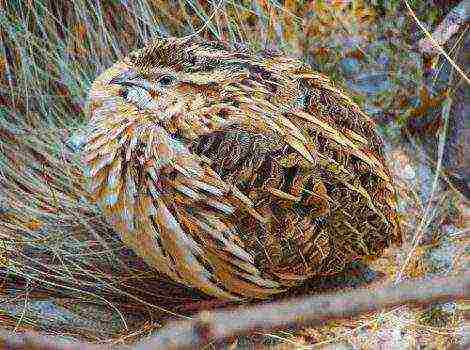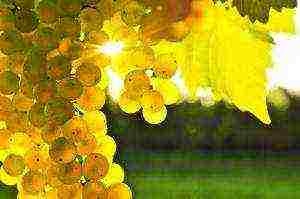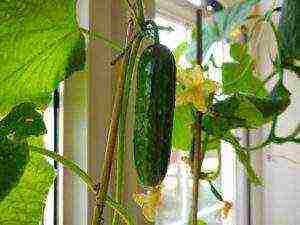Content
- 1 Why do you need a black covering material for cucumbers
- 2 Advantages and disadvantages of using spunbond when growing cucumber
- 3 Types of black covering material
- 4 What material is good and how to choose
- 5 Preparation of beds in the open field
- 6 Disembarkation
- 7 Care features
- 8 Method description
- 9 Pros and cons of the method
- 10 White polypropylene
- 11 Black polypropylene
With the dacha season approaching, many are beginning to think about how to grow vegetables on their personal plot, while achieving maximum yields. The most painful issue is the cultivation of cucumber - a rather capricious culture. To minimize negative phenomena, many use a special covering material. This technology made it possible to grow this vegetable even in cold climates.
Why do you need a black covering material for cucumbers
The culture is rightfully considered one of the fastidious, although it is traditionally planted by each owner. Plant does not tolerate cold weather and strong shade, but it can burn out under strong sunlight.
An important value is given to the parameters of the moisture content of the soil composition and air, which must be maintained mainly artificially. There are still a sufficient number of conditions that are necessary to obtain decent harvests.
In fact, creating optimal conditions for growing cucumbers in the open air is almost impossible, for this reason, the culture is planted under a shelter.
This allows in the middle of the spring season sow seeds or transplant seedlings without fear of any late frost.
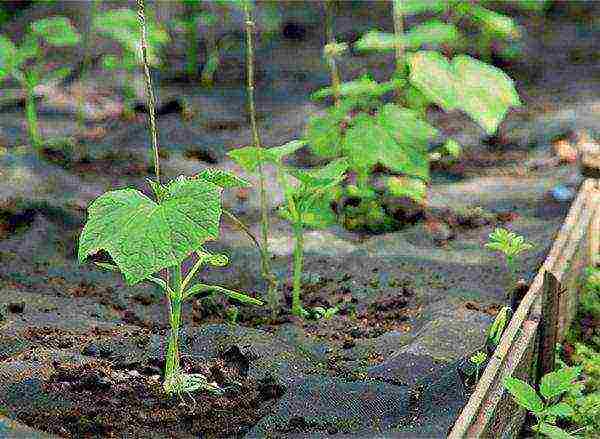 Covering with a film allows you to plant seedlings in the ground in the middle of spring
Covering with a film allows you to plant seedlings in the ground in the middle of spring
The use of a covering material immediately eliminates a number of problematic issues. If you cover the cucumbers, the sowing season can be started a little earlier than usual, and the first harvest will arrive in time faster, because the plants will reliably protected from wind and frost.
The protective film reduces exposure to sunlight, increases humidity, reliably protects the beds from harmful parasites and diseases that can destroy plants.
Covering materials are different. Today the market offers consumers:
- reinforced polyethylene film;
- air bubble wrap;
- PVC film;
- non-woven "spandbond";
- simple polyethylene.
Opaque agricultural linens and films are considered the most popular. The seedling beds are first covered with a canvas, which creates protection from wind and frost. As a supplement, a polyethylene film is stretched from above.
Advantages and disadvantages of using spunbond when growing cucumber
On the beds, you can arrange a shelter without using a frame base.
Soft and lightweight covering material does not hurt the culture, perfectly transmits light, air currents and moisture to the ground. It is resistant to ultraviolet rays, accumulates heat, protecting plants from harmful radiation. Can be used in greenhouses as a second shelter. It is easy to use and does not require large financial costs.
Watering is carried out on top of it... It should be added that the film is resistant to damage, it can be stitched, glued and even washed if necessary.
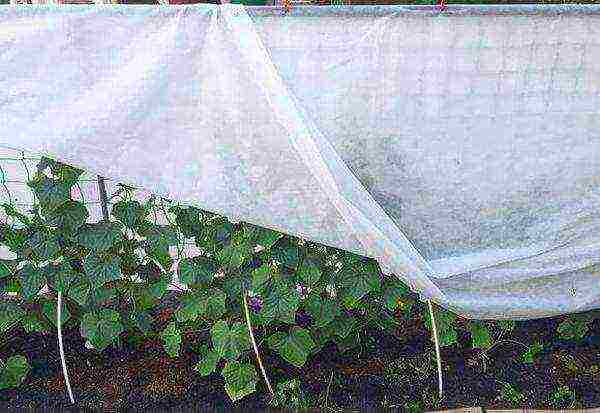 Soft material can be used to cover cucumbers without using a frame
Soft material can be used to cover cucumbers without using a frame
But at the same time, the canvas is not a panacea for all negative phenomena... Much depends on how correctly the variety of cucumbers is chosen for cultivation, how the soil is warmed up.
It is influenced by the density of the film, and even the slope of the beds.In addition, cucumbers require pollination, so the fabric will have to be removed in the morning and pulled again in the evening. Provision should be made for protection from dogs and crows, the main sources of rupture.
Types of black covering material
By its origin, it can be divided into two groups - organic and inorganic.
As a rule, inorganic materials not only cover plants, but also perform decorative functions. These include:
- slate;
- gravel;
- chips of stone, granite, marble;
- crushed stone;
- multicolored synthetic materials.
A separate line should be highlighted black polyethylene... Holes are made in it to add water and fertilizers to the soil. The film keeps heat well, warming up the beds.
Agrotextile fabric Is another interesting option. The type of material is special, often used in agriculture. It is used in greenhouses and open beds. With the help of it, moisture is perfectly retained in the soil, and protection from pests is created.
A distinctive feature of organic materials is the ability to feed the earth, slightly changing its acidic environment.
Organic species include the following:
- compost from garden waste;
- decayed foliage;
- rotted manure mixed with straw;
- shavings, bark, sawdust;
- needles, peat chips;
- cut grass.
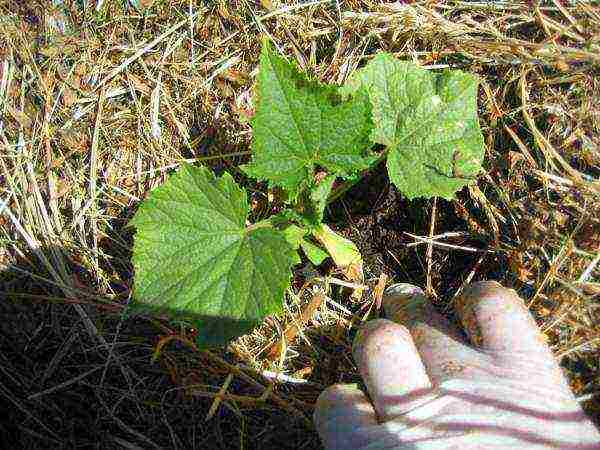 Mown grass as a hiding place for cucumbers
Mown grass as a hiding place for cucumbers
What material is good and how to choose
Before purchasing material for protecting the beds, it is necessary to study the features of each of the known species.
From frost perfectly protect white non-woven fabric - spandbond, agril, agrospan, spantex. They are perfectly permeable to moisture and air, light in weight and quite durable. Their main difference is thickness.
The thinnest ones can be laid directly on the seedlings, pressing down on the edges. A thicker one is suitable for arranging small greenhouses.
In addition, the material must create reliable protection against harmful insectsthat threaten your harvest.
Black films tightly laid on the beds will prevent the development of weed vegetation.
Preparation of beds in the open field
The ridges are prepared in advance, the place should be lighted and warm. Their width is seventy centimeters, you need to dig to the depth of the shovel bayonet.
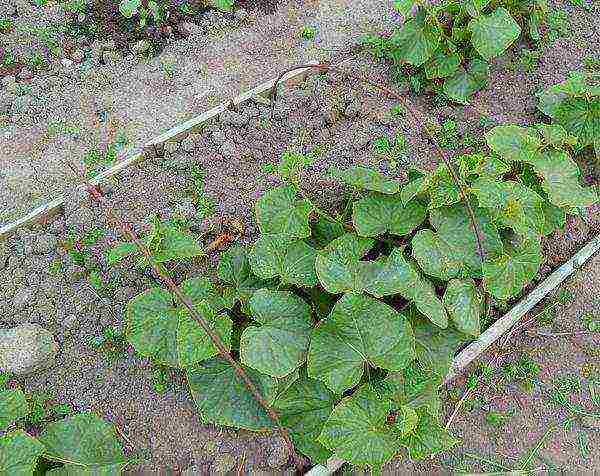 The width of the beds should be about 70cm
The width of the beds should be about 70cm
After that, organic fertilizers, compost, humus are scattered over the surface. The topsoil is leveled with a rake. Now you can arrange the grooves for sowing cucumbers.
Disembarkation
For ten liters of water heated to fifty degrees, we dilute two ampoules of a liquid stimulant. With the resulting solution, spill the furrows abundantly.
Seeds are sown at intervals fifty centimeters... They are carefully pressed into warm, moist earth, sprinkled on top, lightly pressed with your hand.
The whole garden powdered with ground black pepperso that the seeds are not damaged by ants, the sprouts are not eaten by slugs or mice.
After that, the bed can be covered with spunbond in two layers.
Care features
In the spring, the material will reliably protect from frost, in the summer it will save from the heat. But you should maintain the conditions necessary for the normal development of cucumber plants.
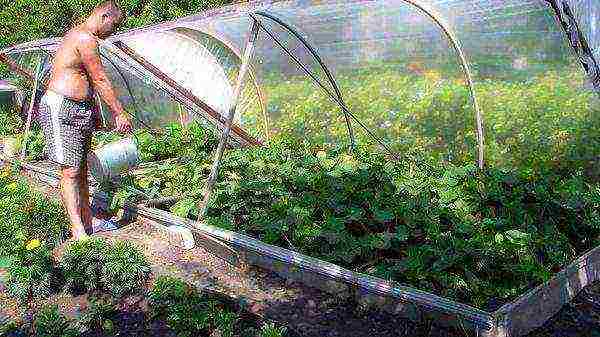 Watering cucumbers under the film is carried out 2 times a week
Watering cucumbers under the film is carried out 2 times a week
Having planted a crop in early April, frequent watering should not be performed. This procedure is enough twice a weekusing warm water. The film should be lifted every seven days in sunny weather to give the seedlings additional light.
May it is allowed to start feeding, but during the day the temperature regime should be about twenty degrees Celsius, not lower.
It is best to use sodium humate for this, which is dissolved in water at the rate of one spoonful per bucket of water. The solution is consumed in the amount of eight liters per square of planting. Poultry manure is used as fertilizer once a month.
When the plants have formed the third leaf, the supports can be set up.Yes, and we should not forget about pollination - the material must be removed from the beds for a day, opening access to insects.
Protection can significantly increase the possibilities of growing cucumbers in different climatic conditions. A well-chosen means of shelter will make it possible to increase productivity, reduce the cost of labor for caring for the beds.
 Covering material: early and abundant harvest
Covering material: early and abundant harvest
The approaching start of the summer cottage season makes one think about planting vegetable crops on the available land plot. Summer residents invariably face the problem of how to achieve the maximum yield of certain crops. Particularly acute in this case is the question of how to grow a decent harvest of cucumbers, which would be enough not only for preparing summer vegetable salads, but also for preservation for the winter.
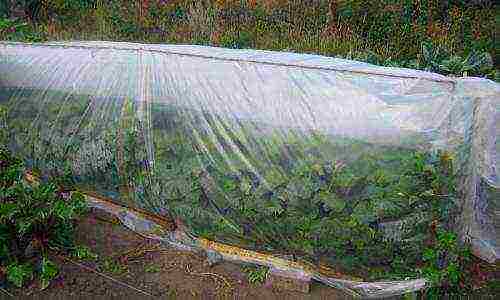
To save the cucumbers from freezing, they must be covered with warm oilcloth.
Cucumbers are actually some of the finest vegetable crops traditionally planted by gardeners. The thing is that these plants do not tolerate cold weather and strong shade of the area, but at the same time, they can burn out under the scorching sun. In addition, the humidity of the air and soil is of particular importance, which must be maintained mainly by artificial means. There are many more conditions necessary to get an excellent harvest.
In fact, it is almost impossible to create optimal conditions for the growth of a cucumber in the fresh air, therefore it is advisable to grow this crop under cover. Growing cucumbers under a covering material allows planting seeds and seedlings of cucumbers already in the middle of spring, while in the open air, planting can only be carried out towards its end, when there are no serious frosts and temperature changes that can only destroy the sprouts that have broken through.
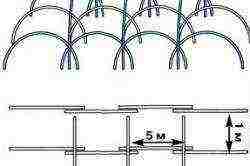
Greenhouse reinforcement scheme.
Not only cucumbers grow better under the covering material. Growing strawberries in such conditions allows you to get a really large harvest of this berry. Surprisingly, the strawberry, from which the strawberry originated, is not so whimsical to the environmental conditions and easily survives any frost, but its domesticated relative requires special care. Given some similarities in growing cucumbers and strawberries under a covering material, it is worth considering the advantages of this technology on these plants.
The use of a covering material solves several problems at once. Firstly, it allows you to start the sowing season earlier and, accordingly, get the first harvest earlier, since the plants will be protected from frost and strong winds. Secondly, during the season, the protective material reduces the effect of the sun on plants, increases humidity, and also protects plants from pests and diseases that can completely destroy the crop. Growing vegetables and berries under cover can significantly increase the yield, so it is worth considering in more detail how to use protective materials and how to properly plant and care for plants growing under the covering material.
Back to the table of contents
Site preparation
It should be said right away that it is possible to plant cucumbers under the covering material already in early April, since the coating will protect them from unexpected drops in temperature.
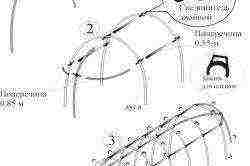
Assembly diagram of a portable arched greenhouse made of arches.
There are several ways to hide seedlings under a covering material. First, you can stretch the covering material over the arcs. Secondly, you can make a rectangular mobile frame and pull the existing material onto it. Thirdly, it is quite possible to fix such plant protection directly on the ground, but this method is the least effective, since the film can be blown away by the wind, and the growth of plants under it will be very limited, therefore this method is not entirely practical.
As a protective material, ordinary plastic film, reinforcement plastic film, agricultural canvas, PVC film, air bubble film and much more can be used. The main parameters when choosing a protective material are: density, ability to protect against temperature changes, transparency, safety. When choosing, you need to proceed from your own preferences and material capabilities.
Arrangement of a plot for growing cucumbers begins with the cultivation of the land. First, you need to dig the earth to the depth of the shovel entry. After digging the selected area, you need to carefully break up the existing lumps and level the selected area with a rake. Next, you need to make longitudinal beds with a hoe so that one bed is located 50 cm away from the other.
After preparing the land for planting, you can proceed to the design of the frame, that is, the installation of arcs or a rectangular box prepared in advance. It should be borne in mind that the optimal height of the structure is 1 m, since in this case the owners of the summer cottage will be able to install supports under the structure so that cucumbers can curl along them.
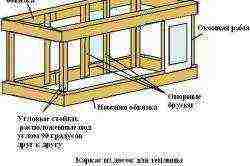
Diagram of a greenhouse with a wooden frame.
If desired, the arc structure can be made independently or purchased ready-made. The installation of an arc structure, as a rule, takes a little time, since in this case the segments are either simply stuck into the ground, or connected to each other at the bottom and can be fixed by pinning the bottom of the structure to the ground.
A rectangular box is usually formed in place from old planks or old scrap metal. It is not necessary to make a very strong structure, so parts of it can be knocked down or twisted with bolts so that it can be easily disassembled in the future. The structure on which the covering material will be attached should be slightly larger than the prepared bed. After carrying out the basic preparations, you can proceed to the direct planting of plants.
Back to the table of contents
Planting seeds and seedlings of cucumbers under the film 
For cucumbers to grow better, they need to be planted with seedlings.
Cucumbers can be planted both as seeds and seedlings. If you want to get the first harvest as soon as possible, it is best to use the seedlings, since in this case the plants will already get a little stronger before being directly planted in the ground, with further coating with a protective material.
Planting seeds is also possible, but it is best to use this method when planting at the beginning of May, since at this time strong temperature drops are already unlikely, which can destroy only the sprouts that have hatched. It is worth considering in more detail how to plant cucumbers in one way or another, so that the plants start growing as quickly as possible and please with a bountiful harvest.
Cucumber seedlings can be grown directly on your windowsill in deep beer glasses filled with a mixture of peat and earth. The seeds are first germinated and then planted in glasses and developed in a warm environment. After the first normal leaf appears, the seedlings can be planted in the ground. In order for the seedlings to take root in a new place and not experience stress due to transplanting and temperature drops, which takes place on the street and in the living room, the soil into which the planting will be carried out must be warmed up. The easiest way to warm up the soil is to pour boiling water over it.
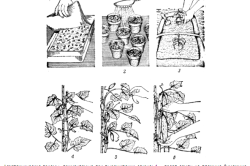
Cucumber cultivation scheme.
In this case, boiling water will also kill a large number of pests. Boiling water must be poured directly onto the formed beds. Seedlings of a cucumber are planted in pairs at a distance of 50 cm. It is necessary to plant seedlings so that not only the roots are firmly entrenched in the ground, but also part of the stem to the first true leaves.
When growing cucumbers from seeds, you must first prepare them before planting - for this they must be germinated. Germinating cucumber seeds is pretty straightforward.In this case, you need to take gauze, fold it in several layers so that it is not too thin and at the same time allows a sufficient amount of air to pass through. Next, the gauze is moistened with warm water and seeds are laid out on one end of it, which are planned to be planted in the future, and the seeds are covered with the other end of the gauze. Thus, the seeds are covered from all sides with a wet, porous cloth. Before pecking, the gauze is placed on a plate, which is placed in a warm place.
Depending on the variety of cucumbers, germination of seeds can take from 3 to 10 days. It is better to plant two seeds in one place with a distance between plantings of about 50-75 cm.The depth of planting seeds should not exceed 1.5 cm, and it is very important to plant them with a narrow part upwards and at the same time not damage the leaves, which have already begun to hatch. After planting, you need to tighten the frame with a protective film to keep warm and protect the seeds or seedlings. At the base, the film is securely fixed with stones or by pouring a significant amount of earth on it.
Back to the table of contents
Proper care of early cucumbers 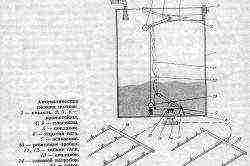
Diagram of an automatic irrigation system.
In spring, the covering material serves as protection against frost, and in summer against heat, but it is very important to maintain other conditions necessary for plant growth. When planting cucumbers in early April in the first month, do not water the plants too often. Ideally, watering should be done with warm water 2 times a week. In April, it is recommended to lift the protective cover at least once a week, but only on sunny days, in order to provide young plants with additional light.
In May, when the weather improves, you can start feeding the plants, but it must be borne in mind that feeding can be carried out only when the temperature during daylight hours does not drop below 18-20 degrees. Top dressing is best done with sodium humate, although any other can be used. Sodium humate must be dissolved in a ratio of 1 tbsp. 10 liters of water. The fertilizer solution consumption is approximately 8 liters per 1 sq. M. In addition, it is recommended to fertilize the cucumbers with diluted bird droppings at least once a month. After 2-3 true leaves appear, you need to make supports for the cucumbers so that the plants can trudge up. This is very important, as the plants lying on the ground usually bear little fruit.
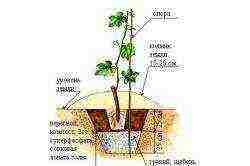
The scheme of planting and garter cucumbers in greenhouse soil.
The appearance of the first flowers when planting in early April occurs already at the end of the month, so at this time it is important to leave the plants at least partially open during daylight hours as often as possible so that pollinators have access to flowers. In the future, when the temperature in direct sunlight exceeds 28 degrees, it is necessary to slightly open the protective material only in the early morning hours, that is, from 5 to 10 in the morning, and in the evening, after 4 hours, this is very important, since the leaves cucumbers are often damaged by direct sunlight.
Back to the table of contents
Agricultural technology for growing strawberries under a covering material 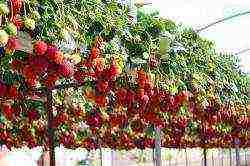
In the greenhouse, it is important that the strawberries receive enough light and moisture.
As mentioned earlier, the agricultural technology of growing strawberries under a protective film is in many ways similar to the technology of growing cucumbers, but still there are specific features that must be taken into account in order to get a large harvest of berries. Firstly, it must be borne in mind that strawberries bear fruit only in the second year after planting, therefore, strawberries are planted in advance - in the fall. A shelter above the strawberries forms around the beginning of May. If you plan to grow strawberries, it is best to use arc structures, while leaving the end parts open for the whole daylight hours. This is very important as pollinators should have maximum access to flowers. Strawberries should be covered completely at night to reduce heat loss.
From mid-May, it is recommended to water the strawberries 2 times a week, and it is better to do abundant watering, since during the period of active flowering and the formation of strawberries, a large amount of water is required. Growing strawberries in semi-greenhouse conditions, which are obtained with the use of protective materials, allows you to provide the partial shade necessary for plants, high air humidity, high temperature and protection from slugs, which are the main pests of strawberries.
Under the protective film, the strawberries begin to bloom about one week earlier. After the berries have formed, the strawberries need to be opened for several hours of sunshine to speed up the ripening process.
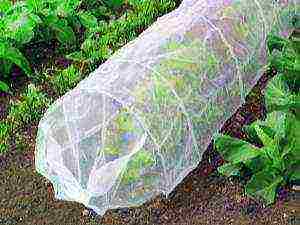
The harshness of climatic conditions in Russia forces many gardeners to build greenhouses or put up greenhouses. But this is a very expensive and complicated matter, therefore, it becomes natural to strive to find an easier way, which turns out to be the cultivation of vegetables under a layer of covering materials.
General information
Planting cucumbers under a covering material turns out to be the most acceptable solution because this plant is extremely capricious. This is quite predictable, because the cucumber was originally grown in hot tropical forests, where it is constantly damp and warm. Even in those regions that are considered warm by Russian standards, the cultivation of such plants is difficult and that is why they are trying to plant them under cover. Skillful application of modern technologies makes it possible to obtain stable yields almost everywhere. Moreover, weather whims, inevitable in some cases, will not spoil them.
If the shelter is made according to all the rules of agricultural technology, you can sow seeds already in the middle of spring or move the seedlings into free soil. Let the frosts return, they no longer pose any danger. As a result, the receipt of the first fee is accelerated.
Additionally, they note such benefits from special shelters, such as:
- reducing the harmful effects of sunlight;
- moisture retention in dry weather;
- prevention of invasions of various parasites and insects.
Varieties
When farmers understand that they, in fact, have no alternative to using a covering system, the next question logically arises - what to use? Now the solution to the problem is mainly:
- structures with a simple polyethylene film;
- film with air bubbles;
- reinforced polyethylene;
- polyvinyl chloride;
- non-woven fabric (spunbond).
The leading positions in the market are occupied by opaque fabrics and films. They can even be combined with each other. In this case, the seedling beds are covered with a canvas that stops the destructive effect of cold and wind. Already over this canvas, polyethylene film is stretched. Now it's worth examining these options in more detail and clearly.
Polyethylene
Polyethylene films for plant cover are supplied in various designs. The main difference between them is due to the thickness of the protective material. There are options for 120, 200, 150, 30, 100, 60 microns. Unlike a number of other coatings, polyethylene with such parameters transmits sunlight. It is distinguished by elasticity and does not allow moisture to pass from the outside, does not collapse if cold weather suddenly sets in.
It should be remembered that when growing plants that are susceptible to direct sunlight, it is advisable to use film covers of different colors with a diffusing effect. The ability to cover plantings from frost directly depends on the density. But in any case, this protective function should not be absolutized.
But the fact that a denser film turns out to be stronger is much more important.
Transparent material, with all its advantages, is easily damaged by ultraviolet rays, therefore, when choosing it, it is required to give preference to light-stabilized coatings.
Non-woven
Non-woven spunbond is no less popular than polyethylene. It allows you to form a shelter even without frames.This material does not harm the landings, it is soft. Even with close contact, it does not deform plants. The non-woven coating will allow light, air, and precipitation to pass through, and will not collapse under the influence of ultraviolet radiation.
The strength of nonwoven fabrics is well known, but not everyone knows that such a material recovers its structure if it is stitched and glued. Can be spunbond and washable. Watering cucumbers is permissible directly from above, without removing the shelter every time. This significantly reduces the complexity of the care.
But it is important to understand that the canvas will give a good effect only if the basic requirements of agricultural technology are met:
- choosing the right variety;
- normal heating of the soil;
- selection of healthy seeds;
- accurate assessment of the required density of films;
- normal slope of the beds;
- protection from animals and birds (which tear mainly the covering material to get to the plants).
Which is better?
The decision to shelter cucumber beds with your own hands logically flows into the search for an answer to the question - what is the best way to hide them? What is important, when answering it, it will not be possible to simply refer to the advantages and disadvantages of the two options already discussed above. If the goal is to save the vegetable from early frost, it is recommended to use a white spunbond stretched on arcs. The most suitable non-woven fabric with a density of 0.023 kg per 1 sq. m.
The allowable spread for this parameter is from 17 to 30 g per 1 sq. m. For full-fledged winter shelters in the form of greenhouses with arches, materials with a density of 42 to 60 g per 1 square meter are recommended. m.
When arranging greenhouses, a film with multi-colored sides (white and black, respectively) also brings good results. The light edge should be at the top, it reflects excess light, and the dark surface makes it difficult for the weeds to live. When choosing a classic plastic film, it is worth giving preference to its reinforced varieties.
No other type of polyethylene will provide the same strength and resistance to mechanical damage. The hardening layer is located in the middle between the two main layers. More often than not, an especially strong film is at the same time protected from ultraviolet radiation.
It is worth considering an alternative such as polycarbonate. It is difficult to find a coating that is more resistant to precipitation and wind gusts. Bacteria do not multiply in polycarbonate, it is relatively light, mechanically strong and almost as good as glass in light transmission. Another important circumstance is that polycarbonate does not ignite. Of the minuses, it can be called the fact that it is unsuitable for laying out on the ground, it only allows the arrangement of permanent greenhouses and greenhouses.
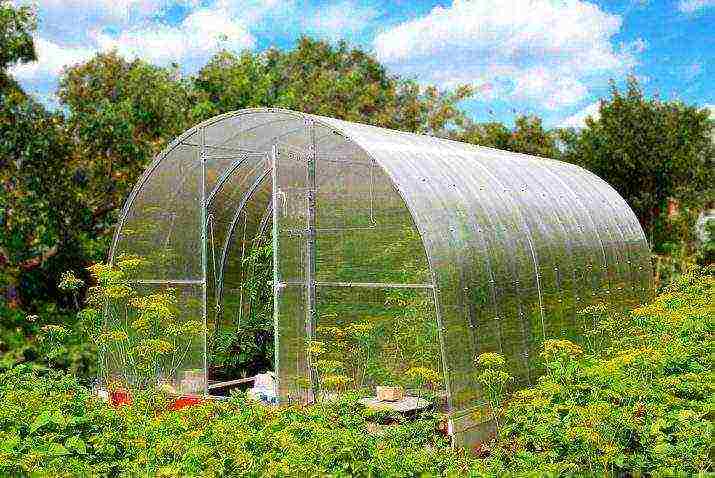 Shelter and care technology
Shelter and care technology
When preparing beds in the open field, you should choose a well-lit and the warmest place, it will be there that it will be easier for the shelter to complete its task. The width of each strip is 0.7 m, and you need to dig deep into the bayonet with a shovel. Be sure to scatter organic fertilizers, selected as needed, they are evenly distributed with a rake along with the top layer. Planting furrows are then formed. A couple of ampoules of liquid stimulating substance are dissolved in 10 liters of water at a temperature of 50 degrees and the area is thoroughly spilled.
It is not worth planting seeds too often, 1 for every 0.5 m is enough. Watering the covered cucumbers is required every three days, only with warm water. At least once a week, if the weather is warm, the shelter is raised to add light.
Feeding usually begins in May, but they must wait so that the air during the day is no colder than 20 degrees. The best feeding for a covered vegetable is sodium humate: 30 g is diluted in 10 liters of water and 8 liters of the finished solution are poured into 1 sq. m of plants, and for additional fertilization, bird droppings are introduced once a month.

To provide a full-fledged shelter, an arc support is required. Moreover, there should be several arcs at once, they are set at an equal distance from each other. Throw the canvas over at night, covering it from above with polyethylene hanging down to the surface of the earth. These edges are pressed down with bricks, boards, pipes without sharp parts.Then neither the air will penetrate, nor the various animals.
The recommended height of the arches is about 1 m. In light frosts and calm, when the sun shines moderately, a simple non-woven fabric is enough for protection. For the summer, it is better to refuse plastic wrap. But the protective cloths still have to be used in the heat to cover from the sun. Occasionally, shelters are placed in the autumn months if the early frosts began before the last harvest.
You can find out about the types of covering material from the following video.
Recently, some summer residents have adapted to growing cucumbers under spunbond, preferring this method to the usual one. This vegetable cultivation method is especially suitable for those who live in areas with cold climates. Growing cucumbers on spunbond, with the correct application of this method of growing vegetables, gives high yields and provides optimal conditions for the growth and development of cucumber bushes throughout the calendar year.

Rules for growing cucumbers under spunbond
Method description
Agrofibre, or spunbond, is an alternative to the well-known polyethylene, which gardeners have been using in the cultivation of vegetables for many years. This material is made from an environmentally friendly polypropylene component with a fine fiber structure.
The essence of the method of growing cucumbers on spunbond is to create a favorable climate for plants at cold air temperatures and insufficient sunlight in northern regions with short summers and at the same time at elevated temperatures in areas with a steaming sun.
Varieties of spunbond
Spunbond for agricultural needs can be used in several of its types:
- a white material that is used in open soil conditions, its density is 17-30g per 1 sq.m,
- white polypropylene with a density of 30 to 60g per 1 sq. m, used for greenhouse and greenhouse structures,
- black density of which is from 50 to 60g per 1 square meter, used for mulching soil,
- black and white spunbond with a density of 50g per 1 sq. overheating,
- white-red, yellow-red materials that protect vegetables from bad weather.
Pros and cons of the method
Among the main advantages of using spunbond in the cultivation of cucumbers and other vegetable crops:
- the softness and lightness of the material, which, when covering the bushes, does not damage or injure them,
- light transmittance of polypropylene, which makes it possible to provide plants with a sufficient amount of light, at the same time preventing from overheating,
- air and moisture permeability, which provides ventilation under the covering material and makes it possible for water to enter the soil,
- UV resistance,
- the ability to accumulate and retain heat,
- ease of use, durability and relatively cheap price.
Spunbond in the process of use can be washed, glued and stitched, which gives additional advantages when using it on a personal plot. At the same time, it is possible to cover cucumber bushes with polypropylene material even without creating frame structures.
You can water the plants without removing the covering material, right on top of the spunbond. Under the fabric, all weeds, without the received sunlight, begin to rot and rot into a natural fertilizer useful for cucumbers. This eliminates the weeding process.
The only drawback when growing varieties of cucumbers without self-pollination is the need to remove material in the morning during the formation of ovaries and cover cucumber bushes with it in the evenings.
White polypropylene
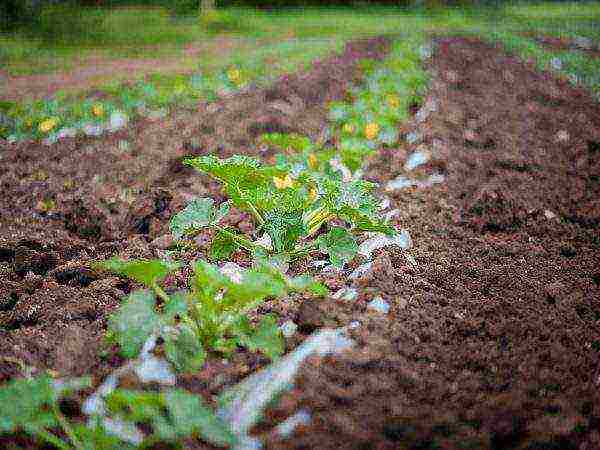
White spunbond allows more light to pass through
Spunbond white is most often used by gardeners instead of the usual plastic film shelter. They can be used to cover cucumber bushes planted with seeds or seedlings in a greenhouse or outdoors. With the help of white spunbond, some people build fabric greenhouses.
To create a structure in the form of a greenhouse, a high density white spunbond is required that will withstand the wind.
White spunbond with a low density of 17gr transmits 80% of the light. Covering material of white color with a maximum density of 60gr is able to transmit 65% of the light.
For light-loving varieties
The plantings are covered with white tissue material with seeds of light-loving varieties of cucumbers. In this case, a material with a density of 17.19.23 grams per 1 sq.m. is used. It can be used both for crops and for already grown seedlings.
When using such a thin white material, we must not forget that it has low frost protection:
- a tissue density of 17g is capable of protecting plants up to -3 ° C,
- spunbond in 19gr keeps plants from frost not lower than -4 ° С,
- material with a density of 23gr can withstand temperatures down to -5 ° C.
For shade-tolerant varieties
For the purpose of laying on the garden bed and for creating a greenhouse effect, white spunbond is used, the density of which starts from 30 grams and reaches 42 grams per 1 sq. M. In this case, the first density is applicable for covering on arches up to 30-35 cm high, and the latter is used for greenhouse tunnels of greater heights.
Agrofibre with a high density is able to create protection for plants when the temperature drops to -6 ° C, while maintaining integrity in wind and precipitation in the form of snow and hail. However, they transmit less light, therefore they are applicable for those varieties of cucumbers that are shade-tolerant.
For thermophilic varieties
In unfavorable climatic regions, summer residents use white spunbond with a maximum density reaching 50-60g per 1 sq.m. Such agrofibre is able to protect plantings from strong winds and frosts down to -10 ° C. It is intended for thermophilic cucumber varieties.
Black polypropylene
When planting cucumbers with seeds or seedlings, black spunbond is used primarily for mulching soil and is not used to create a greenhouse effect. Its density is 50-60g per 1 sq. M.
Tips for growing cucumbers in a greenhouse in the garden
We plant cucumbers in the soil. Growing cucumbers on trellises, under the covering material
Cucumbers under a film without watering and weeding.
GROWING CUCUMBERS IN A GREENHOUSE IS VERY EASY. GARDEN (GARDEN) AND GREENHOUSE
The main purpose of black agrofibre is to rid the land of weeds, turn them into organic fertilizer for vegetable crops, and create a suitable microclimate in the soil.
Unlike white agrofibre, cucumbers will not grow on black spunbond.
Black spunbond is used to cover the soil in the process of planting cucumbers, cutting holes in it and planting cucumber seedlings through them into the ground. As a result, plants grow only in cut-through places, and rot and mold do not develop without moisture and sun. Black spunbond protects ripe vegetables from touching the ground, so cucumbers always remain clean when harvested.
